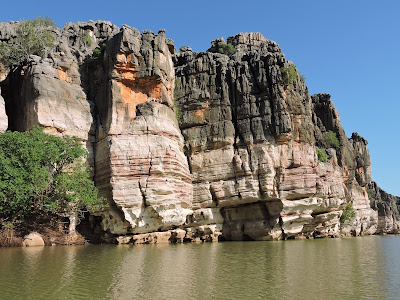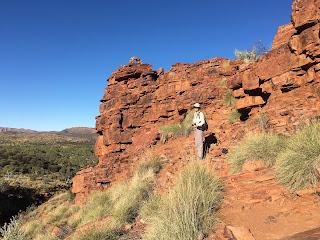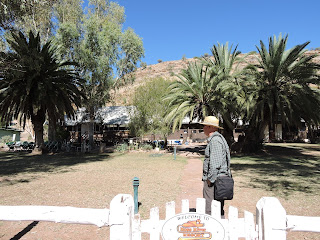 |
| Halls Creek town centre |
 |
| The pool in Halls Creek |
Friday morning we drove out to where the original Halls Creek settlement was located. It was about 16 kms from the current town, along the Duncan Highway, another gravel road that goes up North towards Kununurra. It is the site of the very first gold discovery in Western Australia in 1885. During the gold rush Old Halls Creek was a town of makeshift tents, but it did not last long. Later the site became a small centre of commerce and trade. Some public buildings were erected from mud bricks, including a post office, hospital and police station. In the 1950s the town was relocated to its current site due to lack of water.
 |
| Cemetery, Old Halls Creek |
 |
| The ruins of the post office, Old Halls Creek |

Very little can be seen from the original town. The ruins of the post office are protected under a big roof and high fences. There is a "Lodge" beside the ruins, which from the outside looks also more like ruins, with many old rusting trucks, and machinery, not a very welcoming sight. The old cemetery is just beside, surrounded by high walls made of local rocks. We wandered around the graves and show some interesting headstones.
 |
| An interesting tree |
On the way back we made a detour to Caroline pool, a permanent waterhole in the creek, in between high rock walls. It is a free camping site and swimming is allowed, but did not look very appealing.
Two kms from the town we found the "China Wall", a natural vein of vertical white quartz rising up to 6 metres above the ground for several kms. A very interesting sight, not just the rock wall, but the surrounding vegetation.
 |
| The China Wall |
In the afternoon we had a little walk around the town centre, checked out the "totem" of the local identities, then again enjoyed the freshness of the pool in the caravan park.
Saturday morning we left Halls Creek and by lunchtime we arrived to Fitzroy Crossing. The name of the town refers to the fact that this was the best place to cross the Fitzroy river, the largest in the Kimberleys and one of the longest rivers in Australia. The river has some impressive statistics: during the wet season it can rise up to 26 m higher than in the dry season, inundating everything around it.
 |
| The Fitzroy river |
The visible centre of the town is very small, just a few public buildings, again a huge and well supplied IGA supermarket, most of the residents are aboriginal people living outside in the bush.
We set up camp in the very elegant Fitzroy Crossing Lodge, which offers a range of accommodation, including motel, safari tents and a caravan park. Everything was lush and green, large grassed areas, very surprising after the red and grey stones and dust in Halls Creek. The climate became also much more humid, along the Tanami and in Halls Creek the humidity was at or below 20%, here it was above 60%.
 |
| The pool in the Lodge |
 |
| Geikie Gorge |
 |
| Walking in the gorge |
 |
| A huge boab tree |
Monday (23 May) morning we packed up and continued Westward towards Broome. Along the way we saw the first boab trees, indicating that we really arrived into the heart of the Kimberleys. To our surprise it started to rain and it rained quite heavily for about an hour. The temperature dropped to 20 degrees. Then it stopped and warmed up again, but a thunderstorm was forecast for the afternoon in Broome.
We arrived around 2 pm in full sunshine, but there was no sign of the thunderstorm, other than quite strong winds. We had a site booked in a caravan park just behind Cable Beach, we set up camp, and headed to the beach. It is still as impressive as it was 4 years ago.
 |
| Cable Beach at low tide, Broome |
 |
| Sunset at Cable Beach |
---
Csütörtökön, május 19-én érkeztünk Halls Creek-be, két éjszakát ott mradtunk. Nem különösebben érdekes hely, de szükségünk volt egy kis pihenésre a Tanami sivatag után. Csütörtök délután kicseréltettük a két kipukkadt kereket, vásároltunk egy kicsit a meglepően jól ellátott helyi boltban. Körülnéztünk a városka központjában, egy szép zöld park körül több szinte uj kinézetű középület, és egy jó nagy turista központ. A helyi lakosok többsége aboriginal, egész más karaketerűek mint máshol.
A kemping nem valami jól nézett ki, elég poros és köves, sehol semmi fű, de volt egy szép nagy vízmedence, amit kihasználtunk többször is. A vize ugyan elég hideg volt nekünk, de jó frissítő a 33 fokos melegben.
Péntek reggel kimentünk az eredeti Halls Creek település helyszínére. Kb. 16 km-re a mostani várostól a Duncan Highway mentén fekszik. Itt találtak aranyat először Nyugat-Ausztráliában 1885-ben. Az aranyláz idején a régi Halls Creek település többnyire hevenyészett sátortábor volt, de az aranyláz nem tartott sokáig. Később egy kis kereskedelmi és üzleti központtá alakult. Készült néhány középület agyagtéglából, postahivatal, korház, rendőrség. Víz hiánya miatt az 1950-es években a városkát áttelepítették a jelenlegi helyszínére. Nagyon kevés látható az eredeti településből. A postahivatal romjait magas kerítés védi egy magas tetőzet alatt. Mellette van egy ún. "lodge", ami kívülről szintén inkább romnak néz ki, a szerteszét heverő rozsdás teherautó- és egyéb gazdasági gépek romjai között. A régi temető a lodge mögött fekszik, kőfallal körülvéve. A sírok között láttunk néhány érdekes és megható feliratú kőtáblát.
Hazafelé eltértünk a Caroline pool-hoz, egy állandó vízmedence egy patak medrében, magas sziklafalak között. Itt szabadon lehet kempingezni és fürödni, de a helyszín nem volt nagyon csalogató.
Két km-el a várostól találtuk az ún- "China wall"-t, a Kínai falat. Ez egy természetes szikla-képződmény, fehér kvarc-ér függőlegesen kimagaslik 5-6 m-re a környező talajból több km hosszában. Nagyon érdekes, nem csak a szikla maga, de a környező növényzet is.
Délután mégegyszer sétáltunk a városküzpontban, megnéztük az innen származó hírességek totem-oszlopát, aztán hazamentünk hűsölni a kemping vízmedencéjébe.
Szombat reggel tovább indultunk Halls Creek-ből, és déltájban megérkeztünk Fitzroy Crossing-ba. A város onnan kapta a nevét, hogy itt volt a legalkalmasabb hely átkelni a Fitzroy folyón, ami a legnagyon folyó a Kimberley régióban és egész Ausztráliában az egyik leghosszabb. A nyári esős évszak alatt (december-március) a folyó szintje 26 méterrel magasabbra tud emelkedni, mint a téli száraz évszak idején. Ilyenkor hatalmas területeket eláraszt maga körül, és a főút is járhatatlan.
 |
| A régi átkelő a Fitzroy folyón |
A városka látható központja elég kicsi, csak néhány középület, megint egy jó nagy és jól ellátott mindenes üzlet. Az aboriginal lakosság nagyrászt a városon kívül szétszórva lakik a környéken.
A nagyon elegáns, nagystílű Fitzroy Crossing Lodge-ban szálltunk meg, ami egyben hotel, motel és kemping. Az egész terület gyönyörű zöld, nagy füves területek, meglepő a Halls Creek szürke és vörös poros környezete után. Az éghajlat is nagyon megváltozott, Halls Creek-ben 20% alatt volt a páratartalom, itt meg 60% fölött.
 |
| Ebéd a Lodge kempingjében |
Megint vásároltunk egy kicsit, aztán a délután többi részét a lodge gyönyörű úszómedencéjében töltöttük, trópusi növényzet között. Este kint vacsoráztunk a lakókocsi mellett. Nagyon kellemes este lett volna, de sajnos egy nagy társaság érkezett és pont mögöttünk felállítottak egy nagy ipari hűtőgépet ami borzasztó zajt csinált egész este.
 |
| Fitzroy River Lodge |
 |
| Geikie Gorge |
Utána még elmentünk egy rövid gyalogútra is a korall-sziklák között, de nagyon meleg és párás volt, nem sokáig bírtuk. Visszamentünk a lodge-ba, és a nap többi részét a medencében és körülötte töltöttük.
Hátfőn, május 23-án tovább indultunk nyugatnak, Broome felé. Útközben megjelentek az első boab fák, amik olyan jellemzőek a Kimberley régióra. Meglepő módon eeleredt az eső, és zuhogott vagy egy órát, a levegő is lehűlt 20 fokra. Később elállt és ujra melegedni kezdett, de Broome-ra is vihart jeleztek délutánra.
Két óra tájban értünk Broome-ba, az Indiai Óceán partjára, teljes napsütésben, a viharnak semmi jele nem volt az erős szelet leszámítva. Volt előre foglalt helyünk a Cable Beach mögötti kempingben, letáboroztunk és kimentünk a tengerpartra. Most is olyan csodás látvány, mint 4 éve.
 |
| Megjött a teve-karaván |




































